#i'm mostly referring to newton with this post
Explore tagged Tumblr posts
Text
When you're listening to a playlist and your F/O's theme starts playing.

(Proshippers/comshippers DNI)
#newton pud#lbp3#dimentio bleck#super paper mario#czar jack#animal crossing#i'm mostly referring to newton with this post#but it also applies to my other f/os as well#tia talks#self indulgent#self ship#selfship#self shipping#selfshipping#f/o#f/o community#romantic f/o#self insert#oc x canon#f/o x s/i#self ship meme#self ship memes#self shipping meme#self shipping memes#f/o meme#f/o memes
20 notes
·
View notes
Text
absolutely not complaining bc i love this imagery sm but i'm curious as to why there's so much art of ratio with snakes and apples. yeah yeah fruit of knowledge but why him. what are you trying to imply......
#if it was official art i would've gone insane and used it in my theories btw. ofc#but it's smth i see often in fanarts mostly#the apple can connect to his idle animation. that references newton ofc#and the snake i like to connect to his eyes. @hoyo why does he have snake eyes what does it mean. answer my calls hoyo i'm in your walls#ig there's also an aspect of nudity related to the fruit which i did make a post of how it relates to him like 2 days ago lol#mmmm i love him 🥺👉👈#sorry i fell asleep bc i was extremely exhausted from crying and i just woke up and it's midnight#so ig my brain jumped to thinking abt him as a distraction from *gestures vaguely*
3 notes
·
View notes
Text






Quack Pack Kids (Preteens and Teenagers) and Young Adults (Boys and Girls) - My sketches -Game, Well-To-Do-Duck, Wild, Friend(s), Cultured, Emotional, Obscure and Nostalgic Duck (s) and FREE SPACE DUCKS (plus geese, parrots, rooster and pigeon) - Duckvember - Quack Pack AU and Duckverse (Donald Duck and Ze Carioca comics, Ducktales, Darkwing Duck and Quack Pack) - My style
After a long time, I finally drew my drawings, a newer edition, related to my favorite characters, primarily children (preteens and teenagers) and young adults. I was inspired by the brilliant Alessandro Gottardo, who draws Donald Duck and his family, friends and rivals and publishes them on his Instagram page, and who previously worked on Topolino comics, so he encouraged me to draw my favorite characters in my own way, modeled on his sketches, but this time as a Quack Pack version or as I would imagine them in a Quack Pack version (my version of Quack Pack AU). Since I didn't have time to do everything related to this year's Duckvember, I drew more characters related to multiple themes since it's hard to decide who belongs to whom, but in my own way. I would draw more characters, but I will do that another time, because these are not the only ones who would appear in Quack Pack AU. Yes, I combined Italian, Danish, Dutch, Brazilian comics, Ducktales 1987, Darkwing Duck and the original Quack Pack, in my own way to be in one gathering. Family and friends of Donald's nephews Huey, Dewey and Louie.
And I'm posting on the occasion of Universal Children's Day which is celebrated on November 20th (along with June 1st as an alternative date and the first Sunday of October as Children's Week), so Happy Children's Day! The three separate drawings I drew represent mostly preteens and teenagers as they would look in my Quack Pack version, since it wouldn't fit all in one drawing. The first drawing shows Huey, Dewey and Louie, April, May and June Duck, Gosalyn Mallard and Webby Vanderquack in my style (taking mostly the Topolino style). The second drawing shows boys and mostly features Phooey and Kablooie Duck, Honker Muddlefoot, Zico and Zeca Carioca (nephews of Jose Carioca), Newton Gearloose (Gyro's nephew), Sonny Seagull (Garvey Gull from the Egmont comics), Gene the Genie (more of a boy), Gustav Goose, Doofus Drake, Dugan Duck (Fethry's nephew), and Shamrock Gander (Gladstone's nephew). Yes, Kabooie Duck is Donald's fifth lost nephew and wears mostly brown clothes and is in between my version of Phooey and Honker. Gustav is a friend of Donald's nephews in the Quack Pack, but in my headcanon he is Gus's distant nephew. The third drawing shows girls and young women who are still adolescents, but now adults, more like in their late twenties. This refers to Dickie Duck (Goldie's granddaughter), Loretta MacBridge (Brigitta's niece) and Matilda De Spell (Magica's younger cousin) who is located in the lower part of the drawing. The others are teenage girls Minima De Spell (Magica's niece), Vanessa (a friend of Donald's nephews from the Area 15 comics and mostly Dewey's and Louie's girlfriend), Susie McGuider (from the Quack Pack "Ducks by Nature") and an unknown duck from the Quack Pack from the episode "Shrunken Heroes". Since she doesn't have a name, I decided in my headcanon to name her Dottie Duck and she is Daisy's distant niece who appeared once in an old comic, but is now a teenager. I hope you like this and like these versions.
If you like these drawings and are fans of these characters, feel free to like and reblog this. Just don't use the same versions of mine from my drawings without mentioning me and without my permission. Thanks! Also Happy Children's Day and congratulations to Topolino on their 3600th anniversary edition!
#my fanarts#quack pack#traditional art#anthro art#duckverse#duckblr#artists on tumblr#huey dewey and louie#april may and june#gosalyn mallard#duckvember#webby vanderquack#duck comics#ducktales#honker muddlefoot#darkwing duck#disney ducks#dickie duck#phooey duck#disney birds#zico and zeca#topolino#zico and zeca carioca#minima de spell#newton gearloose#dugan duck#shamrock gander#other characters#ducktales 1987#cartoons
35 notes
·
View notes
Text

Continuing my final days of ShortBox Comics Fair posts (first post here) about the process of bringing "The Maker of Grave-Goods" from idea to completion here, where I'll discuss how I take a page of comics from outline to final art.
So after writing an outline I create lots of these messy stream-of-consciousness "sketch pages" where I write/revise the script, sketch out potential panels, and start fitting them into thumbnails simultaneously. I've never written a script before drawing--the two are too thoroughly linked for me.

I then draw big thumbnails (layouts?). I usually do these at print size on templates I print out as a way to make sure all the text and details will fit/look OK at the final size. This comic was digital and this stage was mostly done in a library so I just roughed things, 2 pages to an 8.5x11 sheet.

After I completed the thumbs and did some revisions on the script, had it copy edited, etc. I moved on to pencils. I printed templates with different divisions (fourths, thirds, etc.) for reference on legal size paper, hand lettered it using an Ames guide, and drew the art using 2B and col-erase pencils. (Unfortunately the paper I used for this was awful, too thin, just the worst)
I inked the pages on nicer paper (Strathmore 400 vellum bristol) using a lightbox. I mostly used Winsor & Newton Series 7 brushes sized 000-0 and Winsor & Newton india ink; but for the lettering and small details I used Japanese nibs (Nihonji for lettering, g nibs & maru for drawing) and speedball ink. And Delter 2 ink for white fixes.
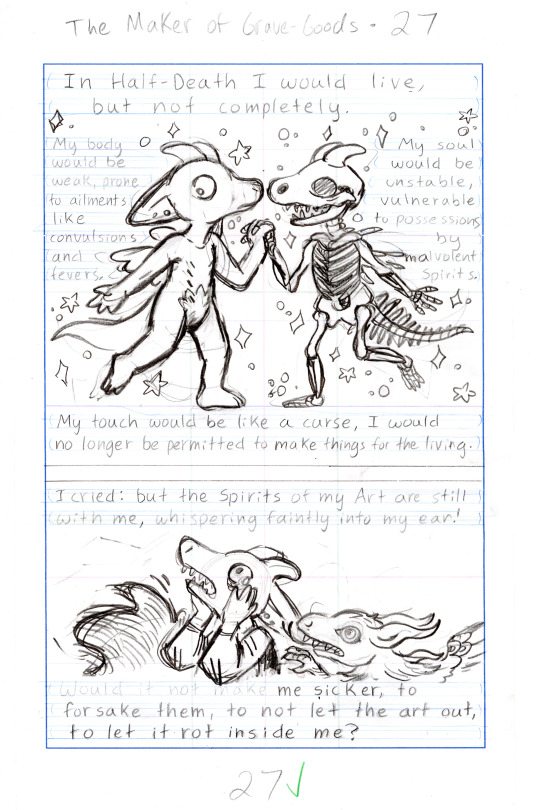

Next is what I think is the most boring part: scanning, dropping images into templates, cleaning up, re-kerning a lot the hand lettered text, to get the traditional inks ready for digital coloring. (Thanks to my partner Sam for assisting with clean-up!)
For the coloring, I wanted to bridge what I'm known for (risograph comics) with digital so decided to treat this comic like a faux two-color riso. I made up two ink colors, "grape" and "phthalo green" and created a digital riso color chart to colorpick from (left) Compare to a real printed one at right.


The coloring uses only colors on that chart and lots of color holds, gradients, big flat spot colors, and even some simulated overprinting like the 2nd panel on the left page. And a noise filter for texture on top. Overall I'm really happy with the coloring--it looks exactly how I wanted it to.

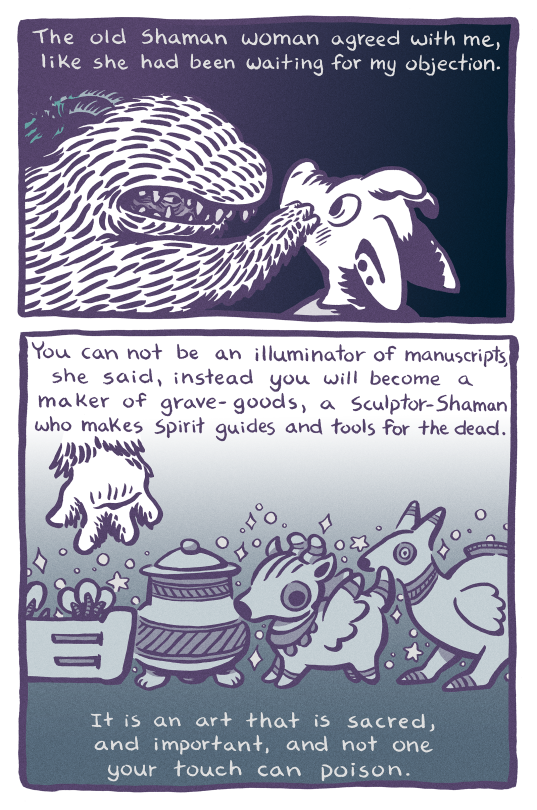
This is pretty typical of how I make comics--I hope it was informative especially if you're interested in traditional media comics making.
Buy "The Maker of Grave-Goods" on ShortBox Comics Fair
#making comics#art process#behind the scenes#shortbox comics fair#webcomics#comic art#the maker of grave-goods#indie comics#traditional media
34 notes
·
View notes
Text
William Blake and Good Omens - an intertextual analysis
Please note: I did another version of this and posted it, but it was quite hurried, way too short, and was incorrect in a number of ways so I deleted it. However it had already been reblogged by the time i did so. If you happen to see another version of this meta that's not the right one, this is the version I'm happy with!
After my previous post re William Blake and Good Omens did so well, and so many people showed an interest I've decided to do a more in depth piece. This is focused upon the TV version of Good Omens, not the book.
Please don't tag Neil in this - although it's mostly textual analysis I do a very small amount of S3 theorising, and I know he doesn't want to see that.
I am in no way suggesting that Neil and Terry specifically wrote Good Omens with Blake in mind, I honestly just wanted an excuse to write more about Blake because I love his work so much, and I thought it would be interesting to try and apply some intertexuality since the works will contain similar themes, both being about God, religion, humanity, and angels and demons.
I also should stress that I am not an expert on Blake, there are people far more qualified to comment on him than I. I'm just a former literature student who loves his work.
There have been many different interpretations of Blake's work over the years, so it's completely fine to disagree with someone else's ideas about it, as with any work of art or literature. And although this piece is likely to be long, I'll barely be able to scratch the surface of all the possible meanings that could be ascribed to it.
Much like the old adage that if someone claims to understand quantum physics they're lying, I'm not sure anyone can truly fathom the full meaning of Blake's philosophy (especially in his later prophetic works, fuuuuuuck those beasts....), so if you're confused by him don't be discouraged, that's perfectly normal!
That being said, I wish to discuss the parallels between Good Omens and The Marriage of Heaven and Hell, my personal favourite and probably the most accessible of his longer works.
"Without contraries is no progression. Attraction and Repulsion, Reason and Energy, Love and Hate, are necessary to Human existence. From these contraries spring what the religious call Good & Evil. Good is the passive that obeys Reason. Evil is the active springing from Energy. Good is Heaven. Evil is Hell."
This excerpt is from near the opening and sets out the central idea of the work - that there is an essential duality to humanity, and each person is a combination of extremes. These extremes are not at war with each other, but rather are equally necessary, hence the "marriage" of the title. "The Marriage of Heaven and Hell" is a metaphor for the human experience.
Consistently throughout The Marriage... Blake refers to the two extremes as Reason and Energy. These terms could be construed in a number of different ways: thought versus emotion, mental versus physical, restraint versus desire, temperance versus excess, caution versus impulsiveness, and following the rules versus free will.
Blake's use of the word "Reason" in this context may be somewhat confusing, however he likely chose it because of his negative feelings towards science and the Age of Enlightenment. Blake saw literal visions of angels and prophets and the divinity of all creation, and hated that science reduced everything to formulas, calculations, and materialism, leaving the world bereft of wonder. "Art is the Tree of Life. Science is the Tree of Death" as he put it.
His ideas about "reason" are best expressed by his painting "Newton". Though inspired by the scientist, it is not a portrait - instead it depicts a figure deeply engrossed in scientific drawings and calculations, totally ignoring the beauty all around him - see below.
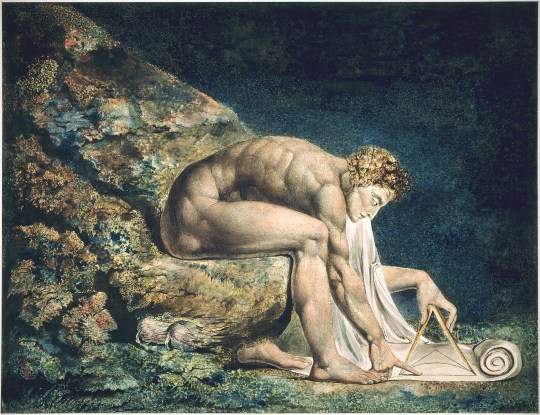
In the context of The Marriage... Reason is "passive" because it involves thought, caution, self-restraint, and doing what you are told, all states which block action. Energy is "active" because it is physical, emotional, impulsive and allows you to act based on your own choices and desires. It's quite clear that Blake feels "energy" is the preferable state - he tells us as much in the next section:
"The Voice of the Devil
All Bibles or sacred codes, have been the causes of the following Errors. 1. That Man has two real existing principles Viz: a Body & a Soul. 2. That Energy, call'd Evil, is alone from the Body, & that Reason, call'd Good, is alone from the Soul. 3. That God will torment Man in Eternity for following his Energies. But the following Contraries to these are True. 1. Man has no Body distinct from his Soul; for that call'd Body is a portion of Soul discern'd by the five Senses, the chief inlets of Soul in this age. 2. Energy is the only life and is from the Body and Reason is the bound or outward circumference of Energy. 3. Energy is Eternal Delight."
So the body is an aspect of the soul, not separate from it, Energy comes from the body, it is Reason which places limits upon Energy, but Energy is eternal delight. Physicality, desire, impulsiveness, emotion, sensual pleasure and free will are not wrong or evil, they are aspects of the human soul and it is from them that we derive our enjoyment of life.
This does not necessarily mean that Reason is always bad. After all, Blake tells us that both are necessary for human existence. Sometimes temperance, caution and thought before action are required. But Reason becomes negative when it "usurps its place and governs the unwilling", i.e. when it completely supplants Energy and becomes the sole guiding factor, forcing passivity.
The Angels of The Marriage... are governed by "systematic reasoning", therefore they are wholly creatures of Reason. They are also "all religious" meaning they believe the "errors" stated above. His Devils by contrast "hate religion" meaning they believe the "contraries", which are the true statements according to Blake. It does not necessarily follow that they are wholly governed by Energy, merely that they believe Energy is "eternal delight".
It is worth noting at this point that Blake saw God and religion as totally separate. For Blake, "God" is that connection with divine wonder which was integral to his life; he tells us plainly that "all deities reside in the human breast" and that "the voice of honest indignation is the voice of God". In other words all humans have a direct and intuitive link with God and don't require the church, Priests, or a religious framework and adherence to a set of rules in order to reach moral decisions. These rules exist only to "enslave the vulgar".
The importance of this ability to make one's own choices about a moral course of action is shown by one of the "Memorable Fancy" sections of The Marriage...
Blake relates how a Devil is able to use an Angel's "systematic reasoning" against them:
"if Jesus Christ is the greatest man, you ought to love him in the greatest degree; now hear how he has given his sanction to the law of ten commandments: did he not mock at the sabbath, and so mock the sabbaths God? Murder those who were murder'd because of him? Turn away the law from the woman taken in adultery? Steal the labor of others to support him? Bear false witness when he omitted making a defence before Pilate? Covet when he pray'd for his disciples, and when he bid them shake off the dust of their feet against such as refused to lodge them? I tell you, no virtue can exist without breaking these ten commandments; Jesus was all virtue, and acted from impulse, not from rules."
The Angel has no way to refute the "reasoning" that Jesus was governed by Energy and "impulse", i.e. his own morality, the "voice of righteous indignation", not reasoning and the rules laid down by Heaven. And because Jesus is the Messiah he must be virtuous, therefore Energy is virtuous. The Angel immediately allows himself to be consumed by fire and is resurrected as a Devil.
How can these concepts apply to the world of Good Omens? This was where my first draft was totally incorrect, as I tried to transfer Blake's ideas about Angels and Demons and Heaven and Hell wholesale, applying "reason" to Aziraphale and Heaven and "energy" to Crowley and Hell. In fact the divide is slightly different in the GO-verse: Crowley and Aziraphale *both* represent Energy, and it is Heaven and Hell that act according to Reason.
At first glance Aziraphale may appear to toe the line - he needs creative application of the rules to make him comfortable with trying to avert the apocalypse, and when he doesn't like the way matters are being handled by the Archangels he seeks a higher authority and goes straight to God. He'd clearly prefer someone to be confirming the rightness of his actions for him. However this doesn't mean that he won't act on his own.
Immediately upon his introduction to the story he has given away his flaming sword, an action that he took impulsively because he felt it was right, not because someone told him to. It bothers him, but he does it anyway.
In the Job storyline, though he initially looks for some loophole within the rules that will allow him to save Job's children, in the end he directly goes against Heaven to do it, even though he believes he is going to Fall and become a Demon for having done so.
Though he resists it and exhausts all other possible avenues first, he eventually does take an active role in averting the apocalypse in S1.
He hides Jim at great personal risk to himself and against the will of both Heaven and Hell, again because he feels it is the right thing to do.
He is therefore perfectly capable of independent action from a position of "righteous indignation".
On a more basic level, he enjoys worldly pleasures, which all come from "energy" according to Blake's philosophy. Food and drink most obviously, but also books, music, dancing, theatre, art and so on.
Crowley is more easy to place as acting from Energy - in spite of the obvious aesthetic differences between them, he also loves worldly pleasures. Alcohol and coffee, snazzy clothing, driving his car with Queen blaring on the stereo, going to lunch with Aziraphale, Shakespearean comedies. All things he isn't supposed to want or need, and which baffle other Demons, in the same way that Aziraphale's desire for food baffles the Angels.
And he's absolutely willing to act according to his own moral impulses when they conflict with Hell's orders (or Heaven's), be it saving Job's children, ensuring that Elspeth doesn't die by suicide, or averting the apocalypse. Yes, he'll try to hide his "good" actions in order to avoid punishment by Hell, but he's firmly "on his own side".
Conversely, Heaven and Hell are both part of the structure of religion in this story, are strictly adherent to a set of rules, and their inhabitants appear to have no real desires of their own, other than possible advancement within the systems they uphold. They are "passive" in that their functions allow the status quo to continue and the "great plan" to unfold as they believe it is meant to, even though each side expects a different outcome.
Again, applying Blake's philosophy, I would say the reason for this is that "energy is from the body". Crowley and Aziraphale have both been given bodies in order that they can exist on earth, and *have* existed on earth for 6000 years, therefore "energy" - physical pleasures and free thinking - have become a part of who they are.
On a more fundamental level, possession of a body can be equated to humanity, and humanity has been shown as the most powerful force of all in this story, its influence having led to Adam becoming "human incarnate", and thus acting according to what he feels is right, instead of fulfilling the function he was destined for.
Heaven and Hell contain no material objects, and the Angels and Demons are spiritual beings, having no bodies, so they are not open to energy, and therefore are wholly governed by Reason, and the preservation of the religious structures within which they exist. Structures which, as for Blake, may not actually have anything to do with God herself. In S1 she is a distant observer, clearly aware through her narration of all that is going on, but not interceding in any way. In S2 she is barely present save for her voice being heard briefly in Job, and overlaid with Gabriel's on two occasions.
Bearing all this in mind, what predictions can we make regarding S3 by applying Blake's philosophy?
"The ancient tradition that the world will be consumed in fire at the end of six thousand years is true, as I have heard from Hell.
For the cherub with his flaming sword is hereby commanded to leave his guard at [the] tree of life, and when he does, the whole creation will be consumed and appear infinite and holy, whereas it now appears finite and corrupt.
This will come to pass by an improvement of sensual enjoyment."
The parallels of the cherub with his flaming sword, and the passage of 6000 years should be obvious to anyone reading this - they have of course been lifted directly from the Bible as they are in GO.
I have read some metas which speculated that Aziraphale's bookshop, or perhaps Earth itself, is a metaphorical stand-in for Eden or The Tree of Life. Aziraphale has been commanded to leave his "Eden" and will now be instrumental in causing the whole of creation to become infinite and holy, but Blake tells us this will be done by an improvement of sensual enjoyment, which arises from Energy not Reason.
Sensual enjoyment is something which is intrinsic to Aziraphale's character, and this could make his placement in Heaven very important.
Putting aside all the "final fifteen" theories and taking matters at face value, Aziraphale tells us that if he's in charge he can make a difference - he needs to subvert the system from the inside out. The most subversive thing of all could be that a sensualist who acts according to "the voice of moral indignation" and "Energy" has become the supreme Archangel. We have seen in Blake how a realisation that Energy could be virtuous was enough to convert an Angel into a Devil (incidentally, does the image of an Angel being consumed by fire and emerging as a Devil seem familiar at all...)
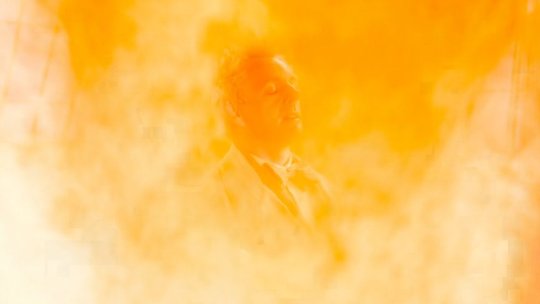
We may have seen the beginnings of this already. Gabriel and Beelzebub became open to Energy from such little things as visiting earth, spending time in one another's company, and their mutual enjoyment of a song, which has given them wants and desires beyond those dictated by Heaven and Hell. This is enough to make them wish to leave their roles behind.
It's possible that the same may happen with Muriel. They haven't yet imbibed food or drink, but they have shown an enjoyment of books, which are an earthly pleasure, and open the reader up to new ideas and ways of thinking.
Of course, this would lead to questions regarding the Metatron's statement that he has "ingested things", and whether this means he is acting from reason or energy. Of course the simplest explanation is that it is a manipulation tactic, and he is lying about having done so, but if true that statement has some interesting implications. However, this is now super-long and I'm out of juice, so will leave others to speculate. I may return to this in the future!
There we go, hope you enjoyed. I doubt this will reach nearly as many people as my first Blake post, but if a few find it of interest then my work is done!
#good omens#good omens 2#go2#crowley#aziraphale#good omens tv#good omens meta#good omens s2#good omens season 3#good omens s3#good omens brainrot#william blake#the marriage of heaven and hell#poetry#poems and poetry#books and reading#english literature#Textual analysis#intertextuality#good omens theories#good omens thoughts
45 notes
·
View notes
Text
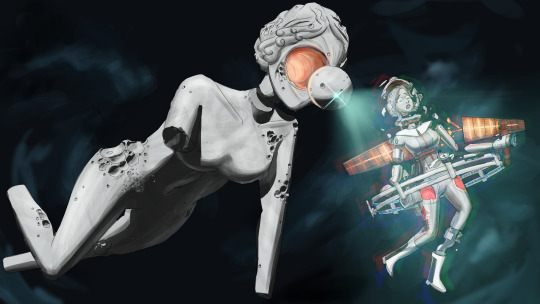
Star Patrol rocket Piccard-5 encounters an artifact of the incredibly powerful White Marble Civilization. circa 2169, colorized & shipgirlified.
Commission for @foxgirlchorix, based on a render by Holly for @torchship-rpg
This is some of my best rendering work ever! These commissions do have a knack for putting me out of my comfort zone enough to continue developing my technical skills and style.
Image ID: Digital art of two ship girls in a black and blue nebula background. One girl is a very large solid white marble statue with a naked feminine form, pitted and cratered with meteoric impacts, drifting belly-down though space. Instead of a face, her head has a large hole which glows yellow-orange, with a white marble sphere held in space outside of it. A green tractor beam is being emitted towards the second girl, a Torchship named Piccard-5. She is a silver girl with her body resembling a star patrol jumpsuit. Warp drive rings circle her waist like a hula hoop. She is wearing a spherical ball helmet. She is wearing white rocket boots. She has glowing red-orange radiator panels as wings on her back. The white marble sphere's tractor beam is slowly disassembling her into individual hull sections, disconnecting her radiator wings, removing her boots to reveal the rocket propellant inside her legs, and taking her body apart. Piccard-5 is reacting with a worried or confused expression. End Image ID.
Artist's notes and concept sketches in the read more:
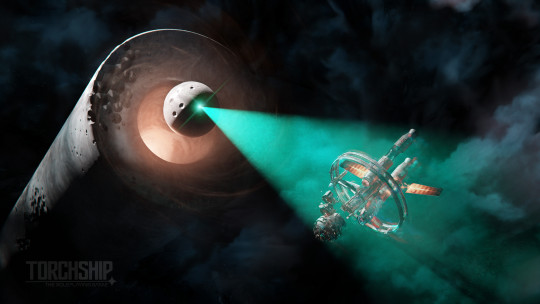
When this render was posted Levana immediately had the idea to make it one of a series she was planning on commissioning me for, of shipgirls based on Torchship's Star Patrol (and alien) rockets. So we quickly brainstormed how it would go down and what she could afford price-wise.
When I do big commissions with new characters where I'm creating the design without an existing OC reference, I charge extra for character design. That doesn't just go to waste! Here's the concept art page:
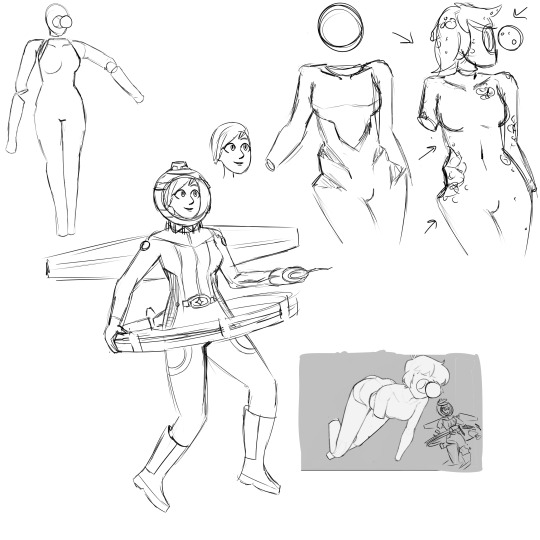
The White Marble shipgirl is inspired by the Eerie and Enigmatic Empty Vessels by @murmurlilies, which Levana really likes--if you look at her blog you might see one of those posts reblogged multiple times. I wanted to pay homage to the eerie and enigmatic empty vessels without directly ripping them off! The first sketch on the upper left is imagining the girl poses by breaking her arms into segments and moving them around, but that never looked quite right to me. The second is basically just a direct study of the empty vessels (with a ball head). The third is after a little more refinement--I liked the cute hair on the empty vessels so I wanted to keep the head mostly intact, and I found a way of keeping the silhouette of the jagged angular hips on the empty vessels but in a very different way! Meteoric impact damage, just like on the original Torchship render. I also used an edited version of one of the Empty Vessels drawings for the thumbnail sketch in the lower right out of laziness.
There's also a sketch of what Piccard-5 looks like when she's not being disassembled. Piccard-5 has a rounded main hull, so it looks much more like a regular space suit helmet than the frustum-shaped helmet on the Newton-2 shipgirl I sketched a while back. The Newton-2 shipgirl had heat radiators as wing shapes on her boots, but making them actual wings on her back makes the disassembly image all the more unsettling.
I changed the hairstyle on the white marble girl when I drew the main drawing because I wanted to evoke like, greco-roman marble statues, and so a curlier/braided look worked better than the cute pixie cut of the empty vessels. I'm really happy with how the final product looks. I knew I wasn't gonna be able to half-ass it with the rendering, you know, just a little shading along the edge; this required a lot of careful thought and it was a lot of fun to do! Especially where the craters interact with the terminator (line between light and dark), just like on the Moon, which I have a lot of experience sketching (see below--the following sketches were made while looking through telescopes at the Moon at night)
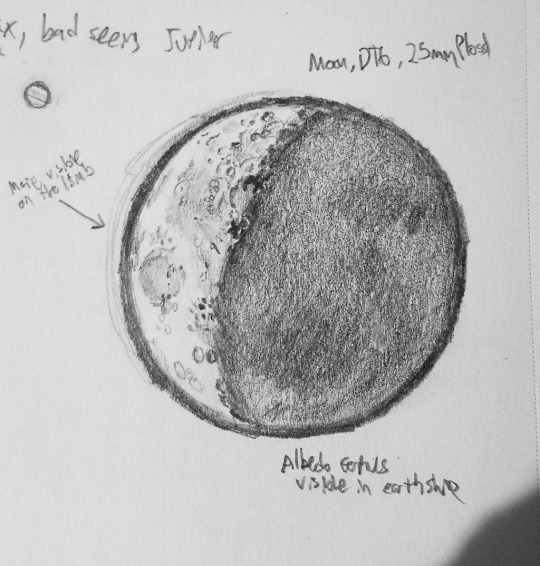
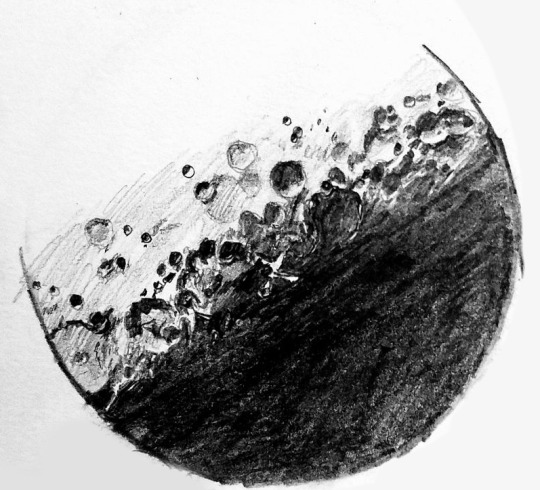
Here's a WIP of just the line-art:

and with the basic shading done on the marblegirl
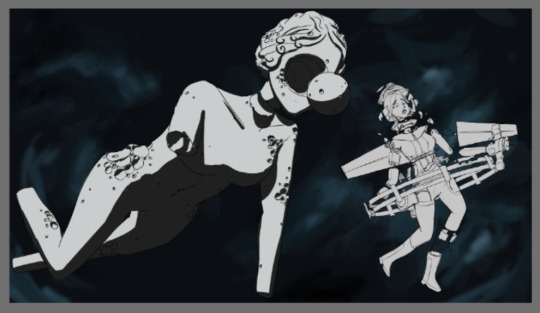
I started with like, a cel-shaded look (?), and then went in and softened the edges, then went over it again to fix the craters. I also added the marble texture to the unshaded base layer.
For the Piccard-5 girl, I spent a lot of time trying to get the pose right. I wanted it to be a little stiff, she's in a suspension beam after all, but not too stiff? And I had to decide like, what pieces should be detached, and where should they be going. In the render, hull pieces are often displaced towards the side, but when doing that to a humanoid, it ruined the pose too much, so i avoided doing too much weird stuff to the torso and kept the disassembled pieces largely to one axis. The cross sections are hollow because they're ship decks. She's a spaceship, not a robot girl. The warp ring was suspiciously untouched by the dissassembly beam in the original render, but i had the marble girl pull a few pieces off of it in my drawing.
Probably the one thing that isn't based on something happening in the render is the belt. Like, rockets don't have belts, cosmonauts do! So that was a fun little touch.
#commission#Torchship#Torchship TTRPG#TTRPG#Digital art#Star Trek#Whale probe#marble statue#rocket#spaceship#space#spacecraft#heat radiator#hard sci fi#science fiction#robotgirl#girl#shipgirl#disassembly#yuri#wlw
69 notes
·
View notes
Text

What is Minecraft's gravitational constant value ?
This post is a follow up to this one, in which we found out Minecraft's acceleration due to gravity value :
When I say gravitational constant, I imply the one regarding players because it depends on the acceleration due to gravity which itself depends on entities in Minecraft (otherwise it's mostly inconsistant).
I'm not gonna lie this topic is way harder than its prequel, and I DID NOT see anything on the internet (not to say there isn't anything) talking about it (so if you wanna argue on smth pls source what your saying).. actually nobody really searched for Minecraft's gravitational constant value.
So here we are looking into that.
First of all, one thing to know is that a Minecraft world spreads over 30 million blocks in each direction of the orthonormal basis (here I'm referring to absolute distances) in 2 dimensions (in every direction except in altitude) :

From this we can calculate the area from a square-like perspective :

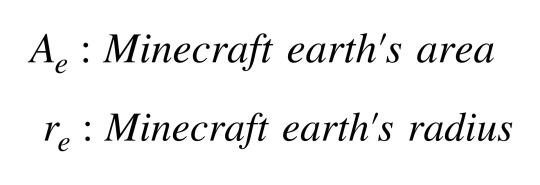

Now most people assume Minecraft´s earth to be a cubic planet but this would mean that a player falling from a certain height get a different falling time depending on the place you are (on corners especially).
After testing it out, I ended up noticing a player's falling time is approximately the same regardless of the place you fall from (from a given height) which only means one thing, Minecraft earth is a spherical planet (might sound very odd to you but it is indeed logical).
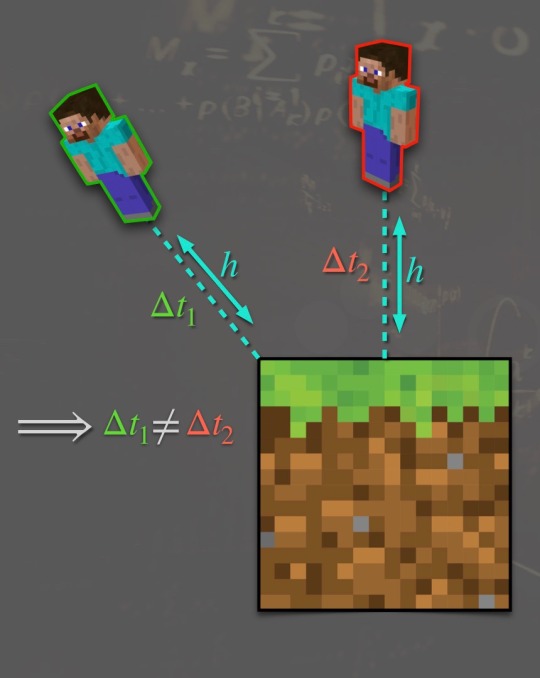
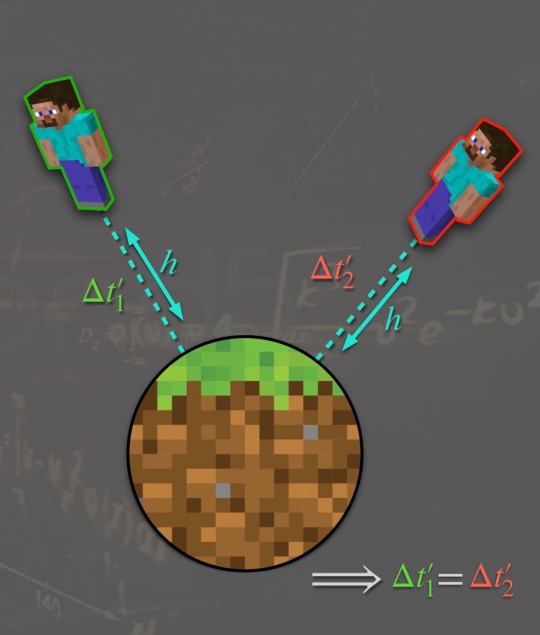
Besides, using the area we calculated and the sphere area formula, we can solve for the radius :
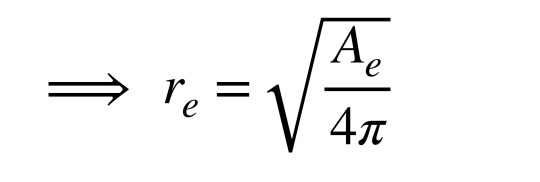

Since we have got both Minecraft earth's radius & Minecraft's acceleration due to gravity value, we can (re)try to use Newton's law of attraction :
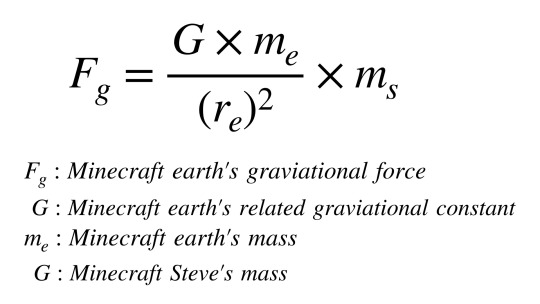
Then after simplifying and solving for the gravitational constant with Newton's second law of motion, we still gotta figure out Minecraft's planet's density (as we can determine the volume, it's better to search for density rather than mass).
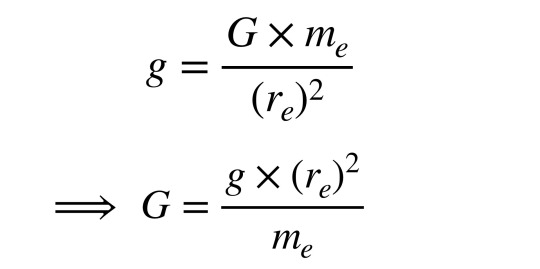
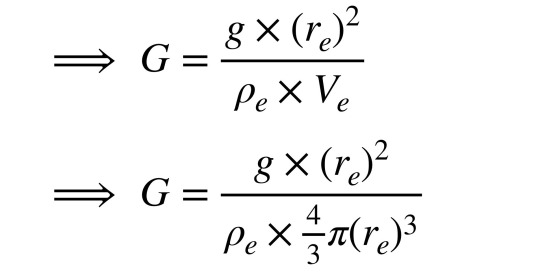
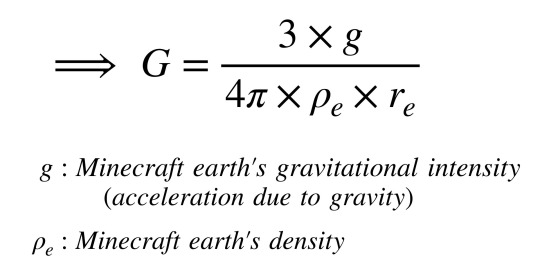
Unfortunately, substituting formulas in equations, making linear systems, the gravitational constant as well as the density always checked out :(
Even after introducing more formulas (like the kappa formula or the escape velocity formula) it couldn't be any more relevant :/
There seems to be something wrong but long after hours upon hours of researches (and dozen liters of sweat that could fulfill a whole swimming pool lol) I realised we could proceed by identification going back to this formula :

A product of 2 unknowns equals a constant (as g and the radius are known).. interesting...
Guess what, in order to proceed by identification, let's dispatch known parameters and constants as well :

Let's now see the numerical approximations of each physical quantities using real-world values beforehand :

Okay so what's important is to look at the scale order of the inverse of the radius, it's a 10^-7 order and it's pretty close to the actual universe's gravitational constant standing with a 10^-11 scale order.
So let us add a 10^3/10^3 in the following way :
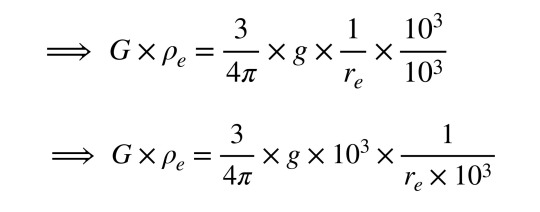
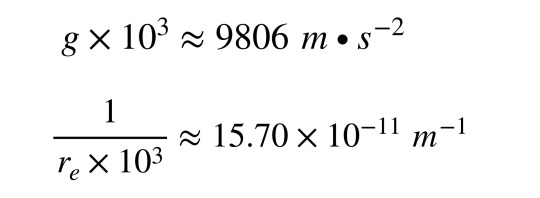
We get to see that 1/(radius*10^3) has got (practically) a scale order of 10^-11.. we're steadily stepping towards the answer guys : )
I also want to point out g*10^3 and density p (rho) scale orders are even.
Which in fact means :

where :

If we break down π into sqrt(π) * sqrt(π) in this manner we get :

with :

Consequently, applying numerical values related to our real-life solar system & earth results in values infinitesimally nearing the actual approxs (it's demonstrated through relative gap calculations being less than 1 %) ;)

hence :
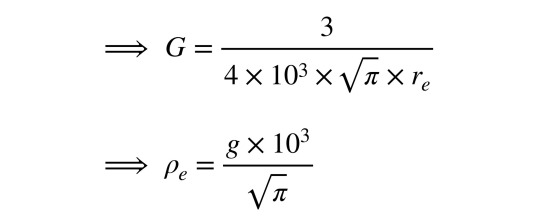
respective relative gaps :

Furthermore, since we study Minecraft's earth planet, we can use the previous final formulas to calculate approximations of both Minecraft's planet related gravitational constant value and density value (as Minecraft suggests a similar solar system to ours in which its earth belongs in) :

Okay we got what we wanted, but let me suggest you a quick understanding to check the coherence of our results.
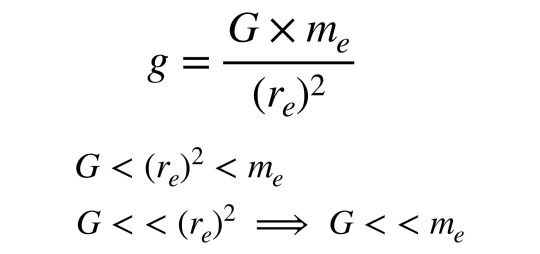
Take a close a look at that formula identified from Newton's law of attraction, we know G (gravitational constant) tends to zero (its value is so small it´s almost zero: about 6.67*10^-11 m^3 • s^-2 • kg^-1) and the radius being a large number.In order to get a final value greater than 1, earth's mass have got to be really large & so the density.
In the case of Minecraft, as the radius is larger and we know the overall division value is approximately 3.23 greater than the real-life one which makes it obvious Minecraft earth's mass, density & volume are greater for sure.
So that's pretty much what we had to do to get an approx of Minecraft planet's related gravitational constant.
Sidenote: It's just a hypothesis, I wanted to make something plausible, cuz assuming our earth's properties to make calculations haven't really satisfied me and isn't correct to apply in a video game (plus people making these assumptions usually don't explain why they use them for a given case).
Also, I'm aware the units aren't possibly correct but all you need is a reference value which wouldn't change the results (1.0 {insert appropriate unit} ) with units making up for the wrong ones.
Edit: For sussy bakas, I solved the whole thing symbolically at first and only (purposefully) numerically displayed intermediate results to picture a significant value but didn't till the final results offline :p
#minecraft gravitational constant#gaming#deep thinking#video games#mineblr#mc#minecraft bedrock#bedrock edition#java edition#deep dive#deep thoughts#nintendo#sony#minecraft steve#minecraft#minecraft oc#science#physics#minecraft java#maths#math#gravitational constant#gravity#minecraft gravity#minecraft gravitation constant value#calculation
78 notes
·
View notes
Text
What if "Raya and the Last Dragon" was a musical? (Concept)

Lemme explain: I REALLY wanted Raya to be a musical. Whenever Disney musicals take place in specific cultures, it sounds GORGEOUS. I mean, just look at the score that James Newton Howard did! Not sure who would do the lyrics, though Stephen Schwartz is the obvious answer. Of course, this wouldn't fix certain story issues I have with it, but I already made a post about that. Something important to note: in my rewrite for the film, the story takes place in a multicultural city in Heart rather than being a travel story, since the original film was a travel story, and my idea about each land representing a specific SEA country would be undermined if we were only in each spot for 10-15 minutes. Tell me what you think about it:
"The Druun"--It'd be a good prologue song in my opinion, and would set the serious and dire tone about unity and the fractured nature of Kumandra. It'd be a short song, but still something eye-catching. It'd be neat if it took inspiration from Indonesian music, given the shadow puppets the original film uses in the prologue.
"Dewdrop"--I love the idea that this is the song that Chief Benja sings to Raya as she grows up in order to convince her to unite the tribes. It'd show how Heart used Sisu's gem in order to focus on making their land a safe haven for those from other parts of Kumandra who want to live peacefully without the threat of warfare. The title would not only reference Benja's nickname for Raya, but also stating that she will be the drop of rain that precipitates the storm of change (plus the dragon's are pretty tied to rain, so it'd be a nifty reference). The song would take mostly from Vietnamese music, given that in my rewrite, Heart is inspired by Vietnam.
"Dep La"--I'm kind of confused on the meaning of this phrase between Namaari and Raya, but let's assume it's a term of endearment for now (and if that doesn't work, the phrase could always be changed since they're kids at this point). They'd meet each other a little bit earlier just so we'd get a montage of a couple years as they become close friends and bond over their hope for unity. I kind of imagine this being a long song, with it being cut off in the middle when Raya shows Namaari where Sisu's gem is. When Namaari reveals her true nature, she sings a darker version of the song, which I suppose could also count as a reprise. It'd start out being largely based on Vietnamese music before blending other cultures to represent unity. In my rewrite, Fang is from a predominantly Indonesian-inspired land with Bruneian and Malaysian influences, so maybe the latter two inspirations could make up the predominant sound since Indonesia was the inspiration for the opening track.
"Trust Me (The Last Dragon)"--Following the time skip, Raya is venturing outside of Heart in order to find Sisu in Tail, though she hides this by stating she wants to invite the chief to a feast in Heart where all the other chiefs (and their gem pieces) will be to discuss the matter of the Druun. This is true in any case (though the other nations received impersonal invitations), allowing Raya to find Sisu, who tells her that she isn't as great as her siblings, telling her the story of how the gem was created. In the end, she still agrees to help Raya, being more wise and less humorous in this version. Given Awkwafina being a rapper, I'd probably take inspiration from rap music, specifically Filipino rap since Tail (in my version) is inspired by the Philippines. In the end, Sisu is able to become a human with the gem piece Raya gives her, and they return to Heart with Boun's help in return for granting him asylum.
"Careful Who You Trust"--Upon returning, Raya has to attend to her chiefly duties to prepare for the banquet and Boun teaches Sisu about credit. While making friends at first in one of Heart's ports on the outskirts of the chiefdom where people from Talon have showed up, she quickly finds that she cannot pay for the items she "bought," resulting in further acrimony towards Heart and its citizens, with the Talon citizens claiming Heart is known for pretending to be kind, only to stab you in the back later. While saved by Dang Hu at first, Sisu is hesitant to share her true identity, to which the chieftess replied she should've thought harder about trusting her earlier, as Sisu is almost attacked by the druun before Raya, Noi and her monkeys, and Boun save her. Given Talon is inspired by Thailand (with Cambodian and Laotian influences), it'd be neat if the song is shown in a way similar to a Lakhol Khan performance.
"Aimless"--After Raya and the gang run into the chief of Spine and his bodyguard Tong (who is much more cynical and broken in this version), Tong is tasked with torturing Raya into giving them her gem piece, and Sisu sees into Tong's heart and saw how much he's lost in the war. Raya realizes that she's not the only person to have suffered greatly in the last few years, and Sisu promises him that their cause is just, showing her true form. Tong relents, managing to get the chief's gem piece and giving it to Sisu. As she flies, some citizens see her and take it as a good omen--unfortunately, some of those loyal to the individual lands take this as a sign that they are doing the right thing for their people. The song is very solemn and contemplative with a healing tone in the end, taking inspiration from Burmese music.
"Dep La (Reprise)"--Following a heart-to-heart between Namaari and her mother, Namaari is torn on how to proceed with stealing Raya's gem piece, regretting the destruction she caused, but also noting how the gem piece that she took allowed the cunning Fang empire to become futuristic, resulting in their more developed culture exhibited modern technology and fashion. Sisu appeals to Namaari and Raya to trust her with her destiny, though Raya confronts Namaari for the betrayal. Namaari deflects, not ready to take the blame for destroying the world, and thus not apologizing for ruining her friendship with Raya. They battle, and Sisu gets caught in the crossfire. Musically, it's very similar to the original "Dep La" song, but more gritty. I really wanted to do a villain Namari song (as I mentioned in my other post that corrupted Namaari would be so cool), but I ended up keeping the Druun as the main villain. Maybe I'll do an alternate plot (and songs) at some point.
"Kumandra"--A song spread out between the petrification of Raya and the others and the end of the film, as Namaari apologizes for hurting Raya and Raya apologizes for not realizing how much she was focused on her own pain and getting revenge. As the other citizens turn back to normal, they join for the communal feast, as Raya's father is the last to become human again. Musically, it'd be a blend of different sounds from all over SEA, perhaps ending with a shadow puppet play similar to how it began.
Lemme know your thoughts! This is just me spitballing ideas, and I'm by now way an expert on SEA culture. Though this does make me want to create tracklists for other Disney non-musicals.
26 notes
·
View notes
Note
I'm sorry I meant 1 2345678910111213141516171819 and 20 for bella and edward
These numbers refer to this headcanon ask list. (I’ve already answered a few for Bella and Edward, but here are the rest.)
Bella:
Their emotional/moral weak spots: Edward, without a doubt. He Who Can Do No Wrong.
Scars or painful spots: I’m really curious what became of James’ bite scar after her transformation. I like the idea of it sticking around; she wouldn’t care much about it, but it would always serve to remind Edward of the time he failed to protect her.
Guilty pleasures: spending days on end with her sparkly vampire husband and literally missing entire phases of Renesmee’s childhood (OK, self-inserting here, but...)
Their vices (physical or emotional): ?
Their tickle spots: VAMPIRES ARE SUPER TICKLISH. Bella’s spot is behind her knees.
Bad memories/experiences: I kind of hope that post-transformation, Bella doesn’t remember any of the times Renee inadvertently made her feel unwanted or unimportant.
Humiliating memories: Just imagine a video mix of every klutz-stunt she’s ever pulled. (yes, self-inserting again *blush*)
Fears/phobias: Were there any in the book, like spiders or anything like that? I can’t remember...
Bad or petty habits: derailing a genuine conversation by getting snarky
Grudges and vendettas: I don’t think she’d ever have a real vendetta, but she’s eternally furious at Jane for burning Edward.
What gets them flustered: when people don’t think Edward is all that attractive
Ingrained habits/forces of habit: putting herself down
What it takes to make them cry: seeing Renesmee cry
Dark secrets/’skeletons in the closet’: none
Regrets: Kissing Jacob (the second time)
Things they’ll never admit: how attracted she was to Jacob
People they’ve hurt or indirectly killed, and how it affected them: She will always feel so bad about hurting Seth when she was a newborn.
What-ifs/Alternate Timelines: I generally don’t think Bella is one to think much about what-ifs, but I think she might sometimes wonder how her life might have played out if she’d never moved back to Forks. Would she have become a teacher? Would she and Edward still have met somehow, destiny-wise?
Turning points in their life: She’d probably say “walking into Biology on that first day.” But in a way, her decision to move to Forks was just as pivotal, and not only in the sense of AU timelines—it was pivotal in that it seems to be the moment when she became more proactive about her life in general. (At least it’s all we have to go on, since we know so little about Bella’s pre-Saga life.)
Edward:
Their emotional/moral weak spots: I was going to reciprocate and say “Bella!” but... I’m not sure that’s quite right for him. Probably his ability to talk himself into Anything, Bella-related or not.
Scars or painful spots: In my headcanon, Edward has two bite scars on his shoulders: one from each of his brothers when he tried to stop them from killing a human.
Guilty pleasures: The big one is my headcanon about his blood scent addiction in 1927 (see my stories/outtakes).
Their vices (physical or emotional): He sure enjoyed mind-maiming Mike Newton in Midnight Sun. I’m pretty sure that went on for the entire Saga, at least until Jacob became a more serious rival.
Their tickle spots: Oh, definitely feet.
Bad memories/experiences: mostly his own dumb choices
Humiliating memories: Whatever final conversation/scene happened when he left Carlisle and Esme in 1927. I’ve seen so many great versions of this in fanfic and all of them continue to make Edward cringe a century later. “How could I ____?”
Fears/phobias: I think he’s pretty much always been afraid, however subconsciously, that he won’t live/isn’t living up to his father’s expectations. First his human father, then Carlisle. I headcanon some good talks circa 1950 that eased that fear somewhat (or least reassured him that these expectations are mostly self-imposed), but it’s never really gone away. In a sense, he has a whole new example that he feels he must live up to, now that he’s a father himself.
Bad or petty habits: I think Edward’s “assassin” comment to Rosalie in Midnight Sun says quite a lot about this.
Grudges and vendettas: Demetri. On the surface, it’s because Demetri is the biggest danger in terms of the Volturi having access to Renesmee whenever they want. But it’s a bit more personal in my headcanon.
Ingrained habits/forces of habit: answering questions aloud that were only asked in people’s minds and driving everyone else in the room crazy
What it takes to make them cry: I think he cried when he returned home in 1931. Carlisle and Esme just held him for hours and hours.
Dark secrets/’skeletons in the closet’: I don’t think he has any dark secrets that nobody knows about. There might be a few things that only Carlisle knows about. And I think there’s a part of him that won’t ever feel “right” until Charlie knows the whole truth about vampires, all the lies he and Bella had to tell along the way, and his rebellious years.
Regrets: *coughing fit* everything
Things they’ll never admit: how much he admires Rosalie as a person
People they’ve hurt or indirectly killed, and how it affected them: The last person he killed in his rebellious years (a 17-year-old much like himself) wasn’t meant to be his target, but he didn’t realize it until it was too late. It sent him into a spiral that led him home.
What-ifs/Alternate Timelines: There are endless possibilities here! I’m curious how things would have gone if he’d stopped hunting humans but hadn’t returned home to Carlisle and Esme. What kind of cover story would he have chosen, living alone? Or would he just be a lurky nomad?
Turning points in their life: Prequel-wise, definitely his rebellious years. In the Saga... probably mid-Eclipse when the light bulb came on and he stopped making Bella’s decisions for her.
18 notes
·
View notes